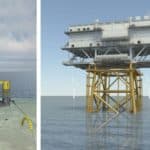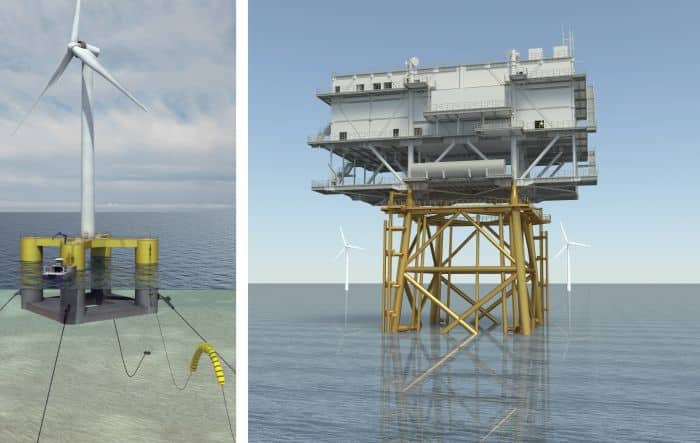
Port Of Antwerp Aims To Built The Largest Network Of LNG Bunkering Vessels In Europe By 2025
March 26, 2021
International NGOs Urge Global Shipping Chief To Arrest Arctic Meltdown
March 26, 2021
The WIND2GRID project was launched in 2020 to promote the collaborative research and development integrating technologies, components and systems for offshore substations with new features, based on the development of a floating offshore substation. The project has a budget of €6.8M for the 2020-2022 period and is funded by the Basque Government’s Hazitek Programme, with the support of the European Regional Development Fund.
The future of offshore wind power lies in the design of new floating offshore substations
The wind sector is constantly advancing towards offshore wind power, with larger and more powerful wind turbines. Turbine manufacturers are immersed in a race to see who can launch the most powerful marine turbine to the market.
There have been news of 12 MW turbines, that improve their performance to become 14 MW turbines; or 14 MW models that could even reach 15 MW with slight improvements. These products are getting increasingly closer to the market.
These large turbines are combined with the search for locations to harness the full potential of wind, seeking deeper mooring areas further from the coast, where bottom-fixed wind power (anchored to the seabed and the most common today) cannot be placed. This is where offshore floating wind power comes into play: different floating platforms are currently striving to position themselves as the best solution for waters deeper than 50 meters.
At this depth, wind turbines as powerful as expected, require substations to collect and distribute the power generated by the offshore wind farms. Aside from this increase in wind turbine power, the trend to make even larger wind farms favor scale economy, and their locations pose certain challenges in terms of power evacuation. Therefore, alternatives in direct current (DC) are being assessed.
These future substations will be floating, flexible, reliable, and modular, so as to adapt to different powers and requirements. Additionally, substations are exposed to the same challenges and demands as the new wind turbines and their floating platforms: new digitalized infrastructures to improve the substation’s O&M, corrosion-resistant materials that can withstand the marine environment, and the overall cost-reduction of the wind farm.
To date, there are no commercial floating substations. Thus, the market opportunity that will be created with the development of floating and fixed offshore wind power at increasing depths is paired with the lack of developers with renowned experience. This creates a unique and unmissable window of opportunity, considering the experience in the development of offshore wind power technology that we have accumulated in the Basque Country. In fact, the two sectors involved in this project, wind and marine power, bring together over 200 companies that could benefit from this new trend in the energy sector.
WIND2GRID: Collaboration of 11 benchmark Basque companies in the wind and marine sectors
Considering this new paradigm, 11 Basque companies decided to join forces in the WIND2GRID project to design and develop a new floating substation concept. The project is also expected to contribute to improve the benchmarking of the Basque industry in the offshore wind sector. In addition, optimal positioning of the Basque marine sector within this key market is essential for its future.
The project is led by IDOM, which will also establish the conditions for the design and the requirements of the substation, as well as the conditions for the evacuation technology. Similarly, the engineering firm will take part in the development of the floating solution, leading the design of the topside of the substation.
- NAUTILUS FLOATING SOLUTIONS, leader in the development of floating platforms for offshore wind turbines, will be responsible for the design of a new floating substation concept.
- GALVANIZADOS SALA, a company devoted to surface treatments and the development of new materials, leads the work package to assess the application of new materials for offshore structures. It will focus on two types of materials: coatings for the protection against offshore erosion and new concretes for large offshore structures.
- OGERCO and VIUDA DE SAINZ will have a greater relevance in this second item. More specifically, OGERCO develops concretes for different structures; whereas VIUDA DE SAINZ is a large construction company committed to R&D and focused on developing new sensors for concrete structures.
- NAVACEL, a manufacturer of large metallic infrastructures for the offshore sector (wind and marine), leads the work package responsible for demonstrating the technical and financial feasibility of the floating substation operations for topside transportation.
- PINE is a leader in electric facilities in the marine and offshore sectors, as well as in the energy and industry sectors. As a true O&M benchmark, the company coordinates the work package to improve and innovate the O&M tasks of offshore substations.
The following companies are also involved in the project in different work packages:
- IBERDROLA, global benchmark operator of offshore wind farms;
- ASTILLEROS MURUETA, shipbuilder specialized in manufacturing ground-breaking ships and naval artefacts, integrating the latest technological advances in the sector;
- CREDEBLUG, manufacturer of handling tools and systems including straps and clamps; and
- ERREKA FASTENING SOLUTIONS, manufacturer of sensorised bolted joints for wind turbines.
The consortium is supported by two centres of the Basque Science, Technology and Innovation Network (RVCTI) -Tecnalia and BCMaterials (Basque Center for Materials, Applications and Nanostructures)- as well as the Basque Energy Cluster.
The project’s goals include the development of a new comprehensive solution that includes new concepts for floating structures that are appropriate for different locations, advanced numeric models applied to studying the hydrodynamic performance of complex structures and dynamic umbilical cables. It also seeks to research the mooring dynamics of large structures in shallow waters, and new DC and AC electric transmission systems.
It will delve into specific high-performance concretes for marine structures and hybrid coatings applied on metallic components to prevent corrosion. Finally, it aims to implement Lean Manufacturing concepts and BIM methods for large marine structures, as well as innovative systems for the repair of submarine cables to reduce O&M costs, while adapting Augmented Reality and Virtual Reality concepts for O&M optimization. In the end, the new floating substation concept that the market is waiting for will be hopefully developed.
Press Release
Source: Maritime Shipping News



